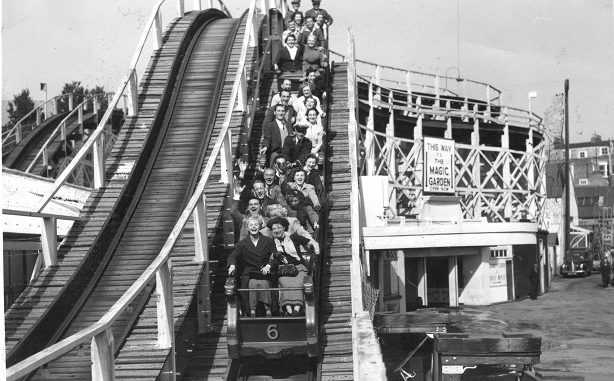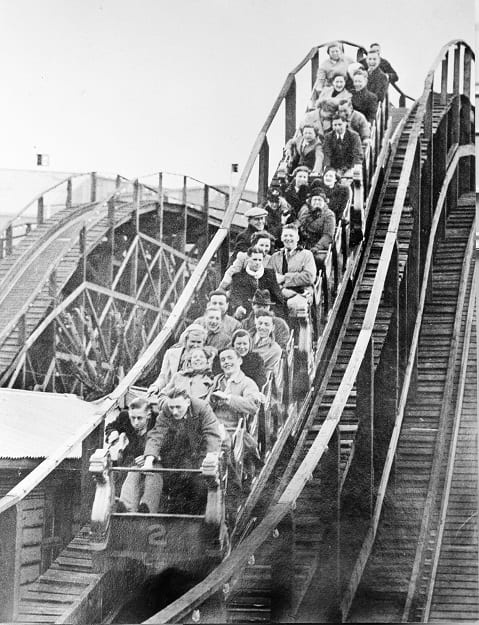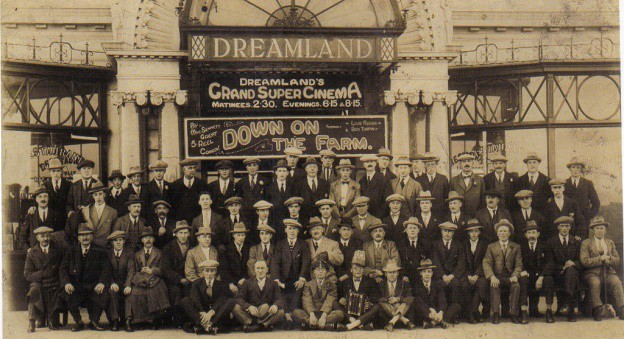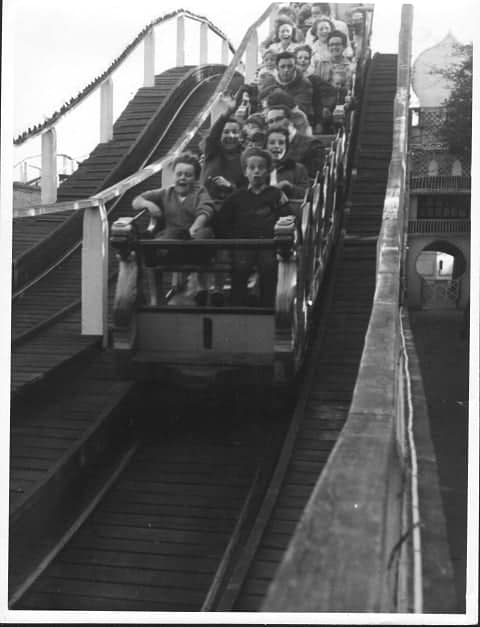
Today (July 3) the Scenic Railway marks its 100th anniversary.
Here the Dreamland Heritage Trust tells the Scenic’s story:
Scenic railways are amongst the earlier types of roller coaster design and the Scenic Railway in Dreamland Margate it is an internationally important surviving example of this technology – and one of the most iconic pieces of seaside heritage in the UK.
The Scenic Railway Dreamland, Margate was built in 1920 by John Henry Iles for his new American-style amusement park.
J H Iles already owned one of Britain’s earliest Scenic railways located in Blackpool and had developed a number of amusement parks around the world.
Scenic Railways were a technological advance from the earlier Switchblade type of roller coaster. Switchblades were patented in 1884 and operated by a lift at the end of each run of linear track to complete the return journey. Scenic Railways were normally on a looped track with the cars inclined by electrically powered endless cables that ran beneath the cars.
Another innovation was the introduction of ‘side-friction’ guide wheels which projected from the undercarriage of the cars to make contact with wooden boards at the side of the track. This development allowed for steeper inclines and tighter, faster curves providing a more exciting ride, but it still required a brakeman to slow cars down on steep descents.
Thirty one Scenic Railways were built in Britain between the first example (the Velvet Coaster at Blackpool in 1907) and the last, in 1938.
The Scenic railway built at Dreamland Margate became the centrepiece of the park. This mammoth construction was made of the finest Canadian Douglas fir and the mechanical parts were shipped over from the USA. The ride cost more than £20,000 to build, and was one of the largest rides of its kind with a track of nearly one mile long.

At Dreamland, the brakeman stood on a platform between the first and second cars of the three-car train which together carried a maximum of 28 passengers.
Dreamland’s Scenic Railway is the oldest of only two remaining in Britain; the other, at Great Yarmouth, dates from 1932. It is the fourth or fifth oldest roller coaster in the world in its original location (and the third or fourth oldest scenic railway) and the second oldest in Europe after the Rutschebanen of 1914 in the Tivoli Gardens, Copenhagen.
Iles marketed roller coasters in Britain and Europe for the American pioneer of roller coaster development, La Marcus Adna Thompson (1848-1919). He thus named the attraction “Dreamland” to reflect the glamour of Coney Island, New York, the home of the world’s leading amusement parks and fairground rides, which between 1904 and 1911 included a park of the same name.

The Scenic Railway opened on 3 July 1920 and was advertised as being the largest roller coaster in Europe. In its first full season in 1921, nearly one million people took the ride.
Dreamland was closed during World War II and the Scenic Railway escaped major damage from the war, but at least half the structure was destroyed by a fire in August 1949. The fire alarm was raised by local resident 21 year old Yvonne Longhi, of Marine Terrace who woke abruptly from a dream about a fire, to see flames engulfing the Scenic Railway and the park, some reaching over 50 feet high. When the fire brigade arrived on the scene they were forced to break through the locked gates, with engines arriving from all over Thanet including RAF Manston, to tackle the blaze.
The aftermath of the blaze saw the management with a major problem, as wood was still a restricted building material, following the war, and was in great demand for the rebuilding of bomb damaged houses.
The answer to the problem came by chance, when Eric Iles and Dreamlands chief engineer Jack Lynch, flew back from Denmark after viewing potential new rides and came across the war damaged remains of Lowestoft pier. The timber proved to be just what was needed to rebuild the Scenic structure and enquiries to purchase the wood were made immediately the plane landed. It transpired that the wood had already been sold to another company but they agreed to sell it to Dreamland. When the timber arrived in Margate one of the first jobs to prepare the wood was the removal of hundreds of 10 inch nails buried deep in the wood, which had held the pier together for years!
Sadly, The Scenic was damaged by yet another fire in 1957.
In 1995, Dreamland reached its 75th year and the Scenic Railway went into the Guinness book of records as the oldest rollercoaster in the UK. But the later twentieth century saw declining attendance and changed ownership of the park, and the Scenic Railway last ran in 2006. The railway was the backdrop for the burning of an Anthony Gormley sculpture The Waste Man in 2006, used in the television film The Margate Exodus.
In March 2002, The scenic railway was designated Grade II* listed for the rarity of it being the oldest surviving roller coaster in Britain and is of international importance as the second oldest in Europe and amongst the five oldest in the world.
On Monday 8th April 2008, the scenic suffered yet another major fire, believed to have been caused by arson. Smoke and flames could be seen coming from the Dreamland site and it soon became evident that the Scenic Railway was on fire. Around 15 fire engines rushed to the scene but due to the lack of mains water pressure at the site, it was difficult for the fire brigade to get the fire under control. Large crowds of bystanders could only look on in despair as the iconic structure continued to smoke and smoulder into the early evening.
By the following morning it became clear that the fire had destroyed all the original trains and about a quarter of the timber superstructure. The entire town of Margate was left mourning the loss of their magnificent roller coaster that had stood at the heart of the town for the past 88 years.
But the Scenic lived to roll again. It was rebuilt as part of a broader initiative to rejuvenate the historic Dreamland amusement park. On 16 November 2009, the Dreamland Trust was awarded a grant by UK’s Department for Culture, Media and Sport to restore the Scenic Railway and other historic areas of the park.
Topbond Plc of Kent were contracted to rebuild the woodwork, while WGH Engineering from Doncaster restored the ride’s mechanical operation.
After a few delays and a stressful build, the Scenic Railway reopened to the public on 15 October 2015 to the delight of local residents and to this day remains an iconic and highly valued part of the town.

Dreamland Margate has since evolved into a stunning vintage-themed amusement park and major music venue with a mix of heritage rides and modern rides. The venue hosts regular family and music events throughout the year, and the beautiful, sweeping the Scenic Railway – framed against the blue sky and sea of Margate – provides the perfect backdrop.
The amusement park and all rides are currently closed due to the COVID-19 restrictions, but will reopen in the future.

